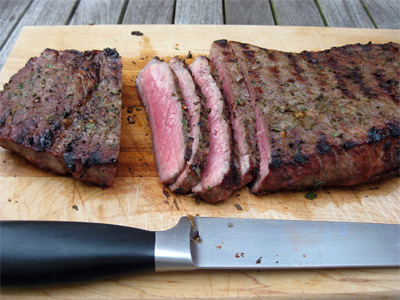 The heat is a-rising here on the East Coast, and when it gets hot, my meals tend to get simpler and simpler. I was a bachelor tonight and made a classic (for me) summer meal, pairing a marinated, grilled london broil with a crispy arugula salad. Lisl always teases me that I never eat starch when she’s not around (she grew up in a household which didn’t count dinner as real unless there was a potato on the plate), and I guess I can’t argue with the evidence clearly in her favor. She is a lawyer after all.
The heat is a-rising here on the East Coast, and when it gets hot, my meals tend to get simpler and simpler. I was a bachelor tonight and made a classic (for me) summer meal, pairing a marinated, grilled london broil with a crispy arugula salad. Lisl always teases me that I never eat starch when she’s not around (she grew up in a household which didn’t count dinner as real unless there was a potato on the plate), and I guess I can’t argue with the evidence clearly in her favor. She is a lawyer after all.
The london broil marinade was a bit east-meets-west, which I enjoyed quite a bit, and the salad was simple, fresh and delicious.
Crispy Arugula Salad
1 bunch of fresh, fairly mature arugula (baby arugula is great, but less peppery)
green pepper
radishes
green pepper
fresh white button mushrooms
fresh thyme
dressing:
lemon juice
champagne vinegar
olive oil
dijon mustard
salt and pepper
Make sure you wash and dry your arugula. Rip the largest leaves in half so the diner does not need a knife to eat the salad, and go with whatever ratios you like for the other ingredients. My salad had enough for two people: half a green pepper, 3 radishes, and 5 button mushrooms.
For the dressing, I used half a lemon, an equal amount of vinegar, a dab of mustard (like an eighth of a teaspoon), a pinch of salt and pepper, and olive oil to taste.
Addition: if you have time to mince up a shallot and let it sit in the lemon juice and vinegar for a few minutes before finishing the dressing, I highly recommend it.

London Broil
4 garlic cloves
2 tbsp of chopped fresh rosemary and winter savory
salt and pepper
soy sauce
cumin
I like to tenderize my london broil (usually a cut of Round) — which entails just putting the meat between two pieces of plastic wrap and giving it a few good bangs with a heavy pot.
For the marinade, wash and dry several sprigs of winter savory (use fresh oregano or thyme if you don’t have savory — I’m now addicted to it and plant it every year) and one big sprig of rosemary, and finely chop the herbs. Then smash the garlic cloves, remove the skin and mince. On both sides of the london broil, spread the herbs, a dusting of cumin, a drizzle of soy sauce, a healthy pinch of black pepper, and a small pinch of salt (given that the soy sauce is salty, I think it is better to go light at this point and taste for salt after grilling). If you have time, cover and put back in the fridge for a few hours. Otherwise you can let marinate at room temperate for 30 minutes or so.
Grill to preference (I like medium rare), let rest for a few minutes, then slice thin.
When it gets hot, I tend to go for whites and roses rather than red wine, so I paired this with a dry Riesling.
Now the only question is whether I let Lisl have any leftovers, or greedily keep it all for myself!









